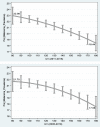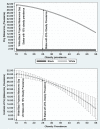Is obesity a risk factor for melanoma?
- PMID: 36814240
- PMCID: PMC9944773
- DOI: 10.1186/s12885-023-10560-8
Is obesity a risk factor for melanoma?
Abstract
Objectives: Are twofold: 1) to estimate the relationship between obesity (BMI ≥30) and the prevalence of melanoma in different US states and 2) to examine the possibility of defining a new risk group. This might enhance the possibility of detection, which in turn, might increase the survival rates of patients.
Study design: A cohort Study, based on data at the US statewide level in 2011-2017, where the dependent variable (the annual new melanoma cases per 100,000 persons) is adjusted for age.
Method: Quadratic regression analysis. This model permits a non-monotonic variation of obesity with new melanoma cases adjusted for age, where the control variable is the level of UV radiation.
Results: Demonstrate a negative correlation between obesity and incidence of melanoma. This outcome is further corroborated for Caucasians.
Conclusions: We should continue to establish primary prevention of melanoma by raising photo protection awareness and secondary prevention by promoting skin screening (by physician or self) among the entire population group in all BMI ranges. Advanced secondary melanoma prevention including noninvasive diagnosis strategies including total body photography, confocal microscopy, AI strategies should focus the high-risk sub group of Caucasians with BMI < 30.
Keywords: Melanoma; Obesity; Risk factor.
© 2023. The Author(s).
Conflict of interest statement
Not Applicable.
Figures



References
-
- Arbel Y, Fialkoff C, Kerner A. The chicken and egg problem: obesity and the urban monocentric model. The J Real Estate Financ Econ. 2020;61(4):576. doi: 10.1007/s11146-019-09737-5. - DOI
-
- Center for Disease Control and Prevention (CDC) (n.d.-a): Overweight & Obesity, Available at: https://www.cdc.gov/obesity/data/prevalence-maps.html Accessed 22 Dec 2022.
MeSH terms
LinkOut - more resources
Full Text Sources
Medical

